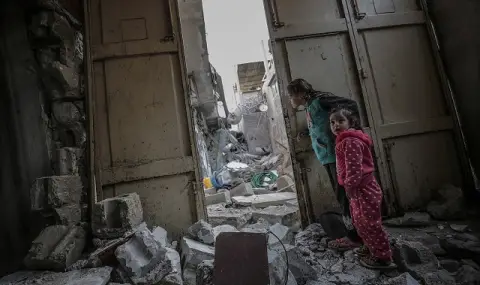Recent actions by the Israeli army in Gaza fuel speculation that the Israeli government will implement a "surrender or starve" strategy. What does she predict?
The latest incursion by the Israeli military into Jabalia in northern Gaza could not have been more disastrous for the residents, who have already experienced the bombings and hardships of the war between Israel and Hamas, which is now in its second year. "It's dangerous here. No one can move. This is risky and dangerous. We were asked to leave but there was no time. "Suddenly, the area was surrounded and under fire," Mohammed, who does not want to give his last name, said on the phone.
About two weeks ago, the Israeli army launched a new offensive in Jabalia and called on civilians to leave the area. According to the Israeli army, Hamas is trying to regroup in the area. The Palestinians and the United Nations fear the operation is part of a larger "surrender or starve" strategy aimed at forcibly evicting residents of the north and separating the northern part of the Gaza Strip from the rest of the enclave. Israel denies such plans.
Mohammed says his wife and three children were visiting relatives in Gaza City when the tanks rolled into Jabalia. He asks his relatives not to return. "With our neighbors, we try to stay close to each other, we share whatever food and water we have left. We don't know how much longer it will last," says the 41-year-old Palestinian.
The UN Office for the Coordination of Humanitarian Affairs estimates that 50,000 people have been displaced from Jabalia in the past two weeks, with others trapped in their homes by heavy fighting around. An "evacuation order" has been issued for about 84% of the territory of Gaza. by the Israeli military.
The situation in Gaza is "terrifying"
Earlier this month, the Israeli army released a map showing new regions to be evacuated - among them Beit Hanoun, Jabalia and Beit Lahiya in northern Gaza. Residents were urged to leave immediately via the Salah al-Din Corridor - the main north-south road - and head to the designated "humanitarian zone" - an overpopulated area with a shortage of basic goods for the people, which is located in the southern part of Gaza. This region has also been targeted by Israel before.
Many are wary of evacuating again and prefer to seek refuge in the northern parts of Gaza despite intensifying bombing and fighting. Aya Tawfiq, who volunteers as a nurse, flees with her family from Jabalia in Gaza City. "We don't want to go south," she says. "The conditions are bad. We don't want to live in a tent, they bomb and kill there too."
In her words, the situation in Jabalia is "terrifying", and the fighting is getting closer and closer to where her family is now. "We live in a house near the evacuation zone. We hear the explosions, the sound of tanks and drones. We don't know if we can stay here any longer," says Taufik.
They fear they will never be able to go home
Emergency services in Gaza say they are unable to reach many of these areas where there is heavy fighting. "This is a huge risk to the safety of paramedics and civil protection," said Fares Afana, who heads Gaza's emergency response. "Many people are injured, there are bodies of those killed in the streets."
According to UN estimates, there are still at least 400,000 people in northern Gaza. Those who remain have different reasons for doing so. Some care for their elderly and sick relatives. Others simply refuse to leave their homes.
Mohammed and Aya Taufiq fear above all that they will never be able to return home. Gaza is already divided from the so-called Netzarim Corridor - a new road that the Israeli army controls. It runs from east to west in the center of the enclave. Locals say the corridor makes returning to northern Gaza virtually impossible.
The interior ministry in Gaza, which is controlled by Hamas, advised people not to evacuate to the south. The Israeli army claims that Hamas fighters are deterring those who want to leave the region.
"Surrender or die"
The latest actions by the Israeli army have sparked speculation among Palestinians, media and humanitarian organizations that the Israeli government is gradually enforcing a "surrender or starve" strategy.
It was proposed by a group of retired senior officers led by retired General Giora Eiland. As part of this plan, civilians in northern Gaza will be asked to evacuate and that part of the enclave will be isolated. Anyone who remains will be mistaken for an enemy combatant, and all supplies will be blocked in a full siege. According to Israeli media, this plan has been discussed by the government, but it is not clear if it has been adopted.
The far-right in Israel want Gaza to be settled
The left-wing Israeli newspaper "Haaretz" reported that, according to their senior sources, some political leaders in Israel are pushing for parts of the Gaza Strip to be annexed. Voices from the extreme right are again heard in support of the settlement of Gaza by Israel. Some far-right groups have even announced that they will hold a "training" to settle in Gaza. However, Netanyahu continues to deny having such plans.
It is not clear whether the Israeli army has actually adopted the strategy of a total blockade of northern Gaza, but sources in the enclave report that supplies of basic necessities to the area are gradually being cut off. Prime Minister Netanyahu announced that the killing of Yahya Sinuar does not mean the end of the war.
For people like Taufik, survival is all that matters. "This invasion is more difficult than the previous one. We don't have energy anymore. We are completely exhausted. We are constantly fighting to survive and not lose our sanity."
